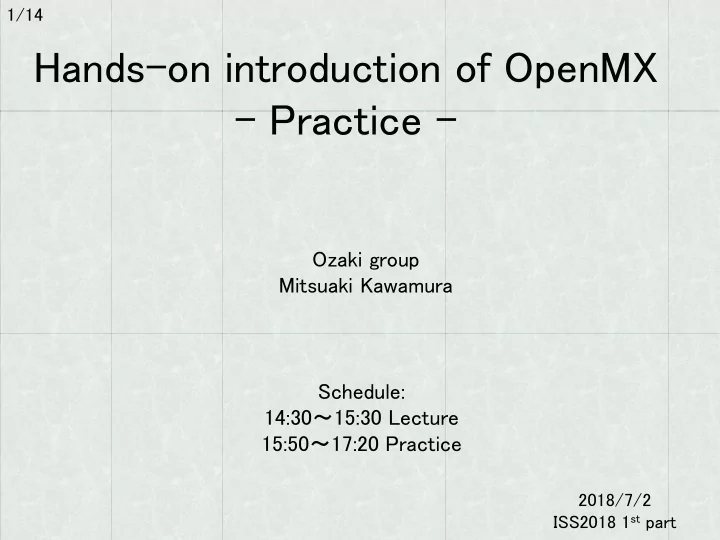

1/14 Hands-on introduction of OpenMX - Practice - Ozaki group Mitsuaki Kawamura Schedule: 14:30 ~ 15:30 Lecture 15:50 ~ 17:20 Practice 2018/7/2 ISS2018 1 st part
2/14 Outline • Introduction • Computer in this tutorial • Configuration • Login • Input file generation • Job submit • Check results • Post processing and visualization • Band structure • Kohn-Sham orbitals • DOS, PDOS, Fermi surfaces • Free excise
3/14 Introduction : Purpose Intro We will overview How to generate and modify the input file and How to display the result
4/14 Flow of this practice Intro Log-in workstation Input file View structure Get CIF file from database Convert cif to input file SCF SC Submit job for SCF Check the result Band structu ture re Plot band structure Submit job Modify input for band Kohn-Sh Sham am orbital al Modify input for displaying orbital Submit job Plot Kohn-Sham orbital DOS a S and Fermi surfac ace Submit job Interactive queue for DOS Modify input for DOS Plot DOS and Fermi surface Free exercise time
5/14 Computer for this summer school Login CPU : Intel Xeon Broadwell 14cores × 2 (28 cores/node) RAM : 64 GB / node Compiler : Intel compiler & MKL library Utilities : /home/public/bin/ (already added to PATH) PC Run numerical calculations Compile ssh login Visualize PC Computational node Edit inputs Execute light program PC Computational node Login node PC Computational node PC Computational node Job queuing system PC qsub command Computational node
6/14 Login to workstation Login Case 1: Use ssh command (Linux, UNIX, macOS, WSL) Your PC may ask you to add this $ ssh -Y user-name @ server-name workstation to “known - hosts”. Enter your password. Case 2: GUI ssh-client in Windows Google “ xming putty” WinSCP is also required in this case.
7/14 Get CIF file from COD Google “ Crystallography Open Database ” “Copy URL”, “Copy Link”, etc. “B2 Mg” into “chemical formula” Alphabetic order In the workstation: $ wget paste-url-here → Input file “openmx.in” is generated. $ fixcod.sh 1000026.cif $ cif2input.py 1000026.cif mgb2 $ VESTA 1000026.cif
8/14 Queuing system $ cp /home/public/iss2018/openmx.sh . $ qsub openmx.sh MPI processes per node #!/bin/sh #PBS -l nodes=1:ppn=7 # Number of OpenMP threads source ~/.bashrc # export OMP_NUM_THREADS=4 # cd $PBS_O_WORKDIR # mpiexec -hostfile $PBS_NODEFILE /home/public/openmx openmx.in -nt $OMP_NUM_THREADS ¥ > openmx.out ppn ×OMP_NUM_THREADS≦ number of cores par node (28) Job status $ qstat – a gauss: Req'd Req'd Elap Job ID Username Queue Jobname SessID NDS TSK Memory Time S Time ----------------------- ----------- -------- ---------------- ------ ----- ------ ------ --------- - --------- 168.gauss kawamura default openmx.sh 23466 1 7 -- -- R 00:00:00 R: Running Nodes Stop job Q: Waiting to start $ qdel job-ID
9/14 Check results $ less mgb2.out $ less openmx.out *********************************************************** *********************************************************** SCF history at MD= 1 *********************************************************** *********************************************************** SCF= 1 NormRD= 1.000000000000 Uele= -14.025399913227 SCF= 2 NormRD= 0.589538957582 Uele= -14.093889873889 SCF= 3 NormRD= 0.249943571587 Uele= -14.122239227622 : SCF= 16 NormRD= 0.000350260351 Uele= -14.150623623150 SCF= 17 NormRD= 0.000216964658 Uele= -14.150651456947 SCF= 18 NormRD= 0.000134457940 Uele= -14.150668805936 SCF= 19 NormRD= 0.000083360095 Uele= -14.150679594319 SCF= 20 NormRD= 0.000051699263 Uele= -14.150686290499 SCF= 21 NormRD= 0.000032833716 Uele= -14.150689700063 SCF= 22 NormRD= 0.000020911680 Uele= -14.150692116404 SCF= 23 NormRD= 0.000000083022 Uele= -14.150697139160 SCF= 24 NormRD= 0.000000081048 Uele= -14.150697139607
10/14 Band structure Edit “openmx.in” with emacs, vim, etc. Line 10 scf.restart off scf.restart on Line 100 orbitalOpt.Force.Skip off orbitalOpt.Force.Skip on Band.dispersion off Line 137 Band.dispersion on Band.Nkpath 9 A <Band.kpath 11 0.000000 0.000000 0.000000 0.500000 0.000000 0.000000 GAMMA M L H 6 0.500000 0.000000 0.000000 0.333333 0.333333 0.000000 M K Γ 13 0.333333 0.333333 0.000000 0.000000 0.000000 0.000000 K GAMMA 8 0.000000 0.000000 0.000000 0.000000 0.000000 0.500000 GAMMA A K M 11 0.000000 0.000000 0.500000 0.500000 0.000000 0.500000 A L 6 0.500000 0.000000 0.500000 0.333333 0.333333 0.500000 L H 13 0.333333 0.333333 0.500000 0.000000 0.000000 0.500000 H A 8 0.500000 0.000000 0.500000 0.500000 0.000000 0.000000 L M 8 0.333333 0.333333 0.500000 0.333333 0.333333 0.000000 H K Band.kpath> $ qsub openmx.sh mgb2.Band $ bandgnu13 mgb2.Band mgb2.GNUBAND $ gnuplot mgb2.GNUBAND
11/14 Kohn-Sham orbitals Band.dispersion off Band.dispersion on Line 137 Modify openmx.in MO.fileout on MO.fileout off Line 311 num.LUMOs 2 num.LUMOs 1 Line 313 num.HOMOs 1 num.LUMOs 2 MO.Nkpoint 1 <MO.kpoint 0.0 0.0 0.0 $ qsub openmx.sh MO.kpoint> mgb2.homo0_0_0_i.cube mgb2.lumo0_0_0_i.cube mgb2.lumo0_0_1_i.cube mgb2.homo0_0_0_r.cube mgb2.lumo0_0_0_r.cube mgb2.lumo0_0_1_r.cube $ cube2xsf *_r.cube $ VESTA *_r.xsf
12/14 Fermi surface, DOS, PDOS (1) Line 311 MO.fileout on MO.fileout off Line 207 DOS.fileout off DOS.fileout on Dos.Erange -20.0 20.0 Dos.Kgrid 28 28 20 mgb2.Dos.val, mgb2.Dos.vec, mgb2.FermiSurf_s0_a1.frmsf, $ qsub openmx.sh mgb2.FermiSurf_s0_a2.frmsf, mgb2.FermiSurf_s0_a3.frmsf $ fermisurfer mgb2.FermiSurf_s0_a2.frmsf
13/14 Fermi surface, DOS, PDOS (2) Interactive queue [XXX@gauss] $ qsub – I [XXX@gaussXX] $ DosMain mgb2.Dos.val mgb2.Dos.vec : Which method do you use?, Tetrahedron(1), Gaussian Broadening(2) 1 ⏎ Do you want Dos(1) or PDos(2)? 2 ⏎ Which atoms for PDOS : (1,...,3), ex 1 2 As well as DOS 1 2 3 ⏎ [XXX@gaussXX] $ exit $ gnuplot gnuplot> set yzeroaxis gnuplot> set xlabel "Energy from E_F [eV]" gnuplot> set ylabel "DOS [/eV]" gnuplot> plot "mgb2.DOS.Tetrahedron" u 1:2 w l tit "Total", ¥ "mgb2.PDOS.Tetrahedron.atom1" w l tit "Mg", ¥ "mgb2.PDOS.Tetrahedron.atom2" u 1:($2*2) w l tit "B"
14/14 Free exercise time • Compute other materials from COD database. Explain the result of band structure, PDOS, Fermisurface. • Install the following visualization tools into your own PC. • VESTA • XCrysDen • FermiSurfer • Try other functions of OpenMX (Wannier function, etc.). • Etc. Tutors Masahiro Fukuda Yung-Ting Lee Mitsuaki Kawamura
Recommend
More recommend